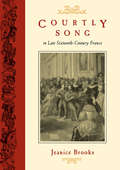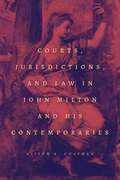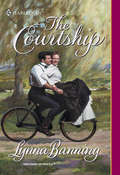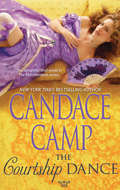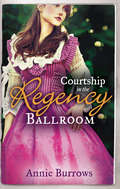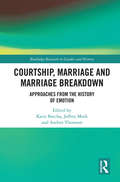- Table View
- List View
Courtly Encounters: Translating Courtliness And Violence In Early Modern Eurasia (Mary Flexner Lectures Of Bryn Mawr College Ser. #2)
by Sanjay SubrahmanyamIn the sixteenth and seventeenth centuries the court was the crucial site where expanding Eurasian states and empires met and made sense of one another. Richly illustrated, Courtly Encounters provides a fresh cross-cultural perspective on early modern Islam, Counter-Reformation Catholicism, Protestantism, and a newly emergent Hindu sphere.
Courtly Encounters: Translating Courtliness And Violence In Early Modern Eurasia (Mary Flexner Lectures Of Bryn Mawr College Ser. #2)
by Sanjay SubrahmanyamIn the sixteenth and seventeenth centuries the court was the crucial site where expanding Eurasian states and empires met and made sense of one another. Richly illustrated, Courtly Encounters provides a fresh cross-cultural perspective on early modern Islam, Counter-Reformation Catholicism, Protestantism, and a newly emergent Hindu sphere.
Courtly Indian Women in Late Imperial India ("The Body, Gender and Culture")
by Angma Dey JhalaExamines the political worldview of courtly and royal women in India during the late colonial and post-Independence period. This book offers a history of the zenana, which served as the 'women's courts' or 'female quarters of the palace', where women lived behind pardah in seclusion.
Courtly Indian Women in Late Imperial India ("The Body, Gender and Culture" #1)
by Angma Dey JhalaExamines the political worldview of courtly and royal women in India during the late colonial and post-Independence period. This book offers a history of the zenana, which served as the 'women's courts' or 'female quarters of the palace', where women lived behind pardah in seclusion.
Courtly Pastimes (Routledge Medieval Casebooks)
by Gloria Allaire Julie HumanThe modern concept of passing leisure hours pleasantly would, in the Middle Ages, have fallen under the rubric of Sloth, a deadly sin. Yet aristocrats of past centuries were not always absorbed in affairs of state or warfare. What did they do in moments of peace, "downtime" as we might call it today? In this collection of essays, scholars from various disciplines investigate courtly modes of entertainment ranging from the vigorous to the intellectual: hunting, jousting, horse racing; physical and verbal games; reading, writing, and book ownership. Favorite pastimes spanned differences of gender and age, and crossed geographical and cultural boundaries. Literary and historical examples come from England, France, Germany, Spain, and Italy. Courtly Pastimes analyzes the underlying rationales for such activities: to display power and prestige, to acquire cultural capital, to instill a sense of community, or to build diplomatic alliances. Performativity − so crucial in social rituals − could become transgressive if taken to extremes. Certain chapters explore the spaces of courtliness: literal or imaginary; man-made, natural, or a hybrid of both. Other chapters concern materiality and visual elements associated with courtly pastimes: from humble children’s toys and playthings to elite tournament attire, castle murals, and manuscript illuminations.
Courtly Pastimes (Routledge Medieval Casebooks)
by Julie HumanThe modern concept of passing leisure hours pleasantly would, in the Middle Ages, have fallen under the rubric of Sloth, a deadly sin. Yet aristocrats of past centuries were not always absorbed in affairs of state or warfare. What did they do in moments of peace, "downtime" as we might call it today? In this collection of essays, scholars from various disciplines investigate courtly modes of entertainment ranging from the vigorous to the intellectual: hunting, jousting, horse racing; physical and verbal games; reading, writing, and book ownership. Favorite pastimes spanned differences of gender and age, and crossed geographical and cultural boundaries. Literary and historical examples come from England, France, Germany, Spain, and Italy. Courtly Pastimes analyzes the underlying rationales for such activities: to display power and prestige, to acquire cultural capital, to instill a sense of community, or to build diplomatic alliances. Performativity − so crucial in social rituals − could become transgressive if taken to extremes. Certain chapters explore the spaces of courtliness: literal or imaginary; man-made, natural, or a hybrid of both. Other chapters concern materiality and visual elements associated with courtly pastimes: from humble children’s toys and playthings to elite tournament attire, castle murals, and manuscript illuminations.
Courtly Song in Late Sixteenth-Century France
by Jeanice BrooksIn the late sixteenth century, the French royal court was mobile. To distinguish itself from the rest of society, it depended more on its cultural practices and attitudes than on the royal and aristocratic palaces it inhabited. Using courtly song-or the air de cour-as a window, Jeanice Brooks offers an unprecedented look into the culture of this itinerant institution. Brooks concentrates on a period in which the court's importance in projecting the symbolic centrality of monarchy was growing rapidly and considers the role of the air in defining patronage hierarchies at court and in enhancing courtly visions of masculine and feminine virtue. Her study illuminates the court's relationship to the world beyond its own confines, represented first by Italy, then by the countryside. In addition to the 40 editions of airs de cour printed between 1559 and 1589, Brooks draws on memoirs, literary works, and iconographic evidence to present a rounded vision of French Renaissance culture. The first book-length examination of the history of air de cour, this work also sheds important new light on a formative moment in French history.
Courtly Song in Late Sixteenth-Century France
by Jeanice BrooksIn the late sixteenth century, the French royal court was mobile. To distinguish itself from the rest of society, it depended more on its cultural practices and attitudes than on the royal and aristocratic palaces it inhabited. Using courtly song-or the air de cour-as a window, Jeanice Brooks offers an unprecedented look into the culture of this itinerant institution. Brooks concentrates on a period in which the court's importance in projecting the symbolic centrality of monarchy was growing rapidly and considers the role of the air in defining patronage hierarchies at court and in enhancing courtly visions of masculine and feminine virtue. Her study illuminates the court's relationship to the world beyond its own confines, represented first by Italy, then by the countryside. In addition to the 40 editions of airs de cour printed between 1559 and 1589, Brooks draws on memoirs, literary works, and iconographic evidence to present a rounded vision of French Renaissance culture. The first book-length examination of the history of air de cour, this work also sheds important new light on a formative moment in French history.
Courtrooms and Classrooms: A Legal History of College Access, 1860-1960
by Scott M. GelberConventional wisdom holds that American courts historically deferred to institutions of higher learning in most matters involving student conduct and access. Historian Scott M. Gelber upends this theory, arguing that colleges and universities never really enjoyed an overriding judicial privilege.Focusing on admissions, expulsion, and tuition litigation, Courtrooms and Classrooms reveals that judicial scrutiny of college access was especially robust during the nineteenth century, when colleges struggled to differentiate themselves from common schools that were expected to educate virtually all students. During the early twentieth century, judges deferred more consistently to academia as college enrollment surged, faculty engaged more closely with the state, and legal scholars promoted widespread respect for administrative expertise. Beginning in the 1930s, civil rights activism encouraged courts to examine college access policies with renewed vigor.Gelber explores how external phenomena;¢;‚¬;€?especially institutional status and political movements;¢;‚¬;€?influenced the shifting jurisprudence of higher education over time. He also chronicles the impact of litigation on college access policies, including the rise of selectivity and institutional differentiation, the decline of de jure segregation, the spread of contractual understandings of enrollment, and the triumph of vocational emphases.
Courtrooms and Classrooms: A Legal History of College Access, 1860-1960
by Scott M. GelberConventional wisdom holds that American courts historically deferred to institutions of higher learning in most matters involving student conduct and access. Historian Scott M. Gelber upends this theory, arguing that colleges and universities never really enjoyed an overriding judicial privilege.Focusing on admissions, expulsion, and tuition litigation, Courtrooms and Classrooms reveals that judicial scrutiny of college access was especially robust during the nineteenth century, when colleges struggled to differentiate themselves from common schools that were expected to educate virtually all students. During the early twentieth century, judges deferred more consistently to academia as college enrollment surged, faculty engaged more closely with the state, and legal scholars promoted widespread respect for administrative expertise. Beginning in the 1930s, civil rights activism encouraged courts to examine college access policies with renewed vigor.Gelber explores how external phenomena;¢;‚¬;€?especially institutional status and political movements;¢;‚¬;€?influenced the shifting jurisprudence of higher education over time. He also chronicles the impact of litigation on college access policies, including the rise of selectivity and institutional differentiation, the decline of de jure segregation, the spread of contractual understandings of enrollment, and the triumph of vocational emphases.
Courts and Courtiers in Renaissance Northern Italy
by Stephen KolskyThe extraordinary cultural Renaissance in the northern Italian courts of the late 15th and early 16th centuries is the subject of this volume. It starts with Baldessar Castiglione's Book of the Courtier (1528) which encapsulates this sense of renewal: his experiences at court and their subsequent rewriting form the backbone of the work. The author then addresses questions of biography, gender, genre, and the varied roles of the courtier, expanding the perspective of Castiglione's text to include the lives and writings of other courtiers and patrons. What was it like to be a courtier? What were the problems associated with such a lifestyle? The importance of women in court circles is also highlighted in studies of one of the most notable of female patrons Isabella d'Este (1474-1539) and of the theoretical developments in writing about gender, stimulated by such women. Stephen Kolsky's analysis of both well-known and comparatively obscure texts brings out the diversity of practices that constituted court society and their centrality to our understanding of the Renaissance.
Courts and Courtiers in Renaissance Northern Italy
by Stephen KolskyThe extraordinary cultural Renaissance in the northern Italian courts of the late 15th and early 16th centuries is the subject of this volume. It starts with Baldessar Castiglione's Book of the Courtier (1528) which encapsulates this sense of renewal: his experiences at court and their subsequent rewriting form the backbone of the work. The author then addresses questions of biography, gender, genre, and the varied roles of the courtier, expanding the perspective of Castiglione's text to include the lives and writings of other courtiers and patrons. What was it like to be a courtier? What were the problems associated with such a lifestyle? The importance of women in court circles is also highlighted in studies of one of the most notable of female patrons Isabella d'Este (1474-1539) and of the theoretical developments in writing about gender, stimulated by such women. Stephen Kolsky's analysis of both well-known and comparatively obscure texts brings out the diversity of practices that constituted court society and their centrality to our understanding of the Renaissance.
Courts and Elites in the Hellenistic Empires: The Near East After the Achaemenids, c. 330 to 30 BCE (Edinburgh Studies in Ancient Persia (PDF))
by Rolf StrootmanRolf Strootman brings together various aspects of court culture in the Macedonian empires of the post-Achaemenid Near East.
Courts, Jurisdictions, and Law in John Milton and His Contemporaries
by Alison A. ChapmanJohn Milton is widely known as the poet of liberty and freedom. But his commitment to justice has been often overlooked. As Alison A. Chapman shows, Milton’s many prose works are saturated in legal ways of thinking, and he also actively shifts between citing Roman, common, and ecclesiastical law to best suit his purpose in any given text. This book provides literary scholars with a working knowledge of the multiple, jostling, real-world legal systems in conflict in seventeenth-century England and brings to light Milton’s use of the various legal systems and vocabularies of the time—natural versus positive law, for example—and the differences between them. Surveying Milton’s early pamphlets, divorce tracts, late political tracts, and major prose works in comparison with the writings and cases of some of Milton’s contemporaries—including George Herbert, John Donne, Ben Jonson, and John Bunyan—Chapman reveals the variety and nuance in Milton’s juridical toolkit and his subtle use of competing legal traditions in pursuit of justice.
Courts, Jurisdictions, and Law in John Milton and His Contemporaries
by Alison A. ChapmanJohn Milton is widely known as the poet of liberty and freedom. But his commitment to justice has been often overlooked. As Alison A. Chapman shows, Milton’s many prose works are saturated in legal ways of thinking, and he also actively shifts between citing Roman, common, and ecclesiastical law to best suit his purpose in any given text. This book provides literary scholars with a working knowledge of the multiple, jostling, real-world legal systems in conflict in seventeenth-century England and brings to light Milton’s use of the various legal systems and vocabularies of the time—natural versus positive law, for example—and the differences between them. Surveying Milton’s early pamphlets, divorce tracts, late political tracts, and major prose works in comparison with the writings and cases of some of Milton’s contemporaries—including George Herbert, John Donne, Ben Jonson, and John Bunyan—Chapman reveals the variety and nuance in Milton’s juridical toolkit and his subtle use of competing legal traditions in pursuit of justice.
Courts, Jurisdictions, and Law in John Milton and His Contemporaries
by Alison A. ChapmanJohn Milton is widely known as the poet of liberty and freedom. But his commitment to justice has been often overlooked. As Alison A. Chapman shows, Milton’s many prose works are saturated in legal ways of thinking, and he also actively shifts between citing Roman, common, and ecclesiastical law to best suit his purpose in any given text. This book provides literary scholars with a working knowledge of the multiple, jostling, real-world legal systems in conflict in seventeenth-century England and brings to light Milton’s use of the various legal systems and vocabularies of the time—natural versus positive law, for example—and the differences between them. Surveying Milton’s early pamphlets, divorce tracts, late political tracts, and major prose works in comparison with the writings and cases of some of Milton’s contemporaries—including George Herbert, John Donne, Ben Jonson, and John Bunyan—Chapman reveals the variety and nuance in Milton’s juridical toolkit and his subtle use of competing legal traditions in pursuit of justice.
Courts, Jurisdictions, and Law in John Milton and His Contemporaries
by Alison A. ChapmanJohn Milton is widely known as the poet of liberty and freedom. But his commitment to justice has been often overlooked. As Alison A. Chapman shows, Milton’s many prose works are saturated in legal ways of thinking, and he also actively shifts between citing Roman, common, and ecclesiastical law to best suit his purpose in any given text. This book provides literary scholars with a working knowledge of the multiple, jostling, real-world legal systems in conflict in seventeenth-century England and brings to light Milton’s use of the various legal systems and vocabularies of the time—natural versus positive law, for example—and the differences between them. Surveying Milton’s early pamphlets, divorce tracts, late political tracts, and major prose works in comparison with the writings and cases of some of Milton’s contemporaries—including George Herbert, John Donne, Ben Jonson, and John Bunyan—Chapman reveals the variety and nuance in Milton’s juridical toolkit and his subtle use of competing legal traditions in pursuit of justice.
Courts of Love, Castles of Hate: Troubadours & Trobairitz in Southern France 1071-1321
by Aubrey BurlThe figure of the Troubadour combines the ideals of knighthood with the inspiration of the poet and musician and created a cultural explosion which influenced the whole course of Western art and civilisation. Burl traces the story from the birth of the first Troubadour in 1071 to the execution of the last Cathar Good Man in 1231 and the close of the distinctive southern French culture that had given rise to it. The tale incorporates the Cusades to the Holy Lands and the Albigensian crusades through the Languedoc and the regular incursions from the English. In telling his story of the Troubadours and their song he brings to life the world of medieval Languedoc. The author is acknowledged as an authority on the Troubadours, one of the most evocative subjects in history.
Courts on Trial (PDF)
by Jerome FrankCONTENTS: I. The Needless Mystery of Court House Government. II. Fights and Rights. III. Facts Are Guesses. IV. Modern Legal Magic. V. Wizards and Lawyers. VI. The "Fight" Theory versus the "Truth" Theory. VII. The Procedural Reformers. VIII. The Jury System. IX. Defenses of the Jury System--Suggested Reforms. X. Are Judges Human? XI. Psychological Approaches. XII. Criticism of Trial-Court Decisions--The Gestalt. XIII. A Trial as a Communicative Process. XIV. "Legal Science" and "Legal Engineering." XV. The Upper-Court Myth. XVI. Legal Education. XVII. Special Training for Trial Judges. XVIII. The Cult of the Robe. XIX. Precedents and Stability. XX. Codification. XXI. Words and Music: Legislation and Judicial Interpretation. XXII. Constitutions--The Merry-Go-Round. XIII. Legal Reasoning. XXIV. Da Capo. XXV. The Anthropological Approach. XXVI. Natural Law. XXVII. The Psychology of Litigants. XXVIII. The Unblindfolding of Justice. XXIX. Classicism and Romanticism. XXX. Justice and Emotions. XXXI. Questioning Some Legal Axioms. XXXII. Reason and Unreason--Ideals.
The Courtship (Mills And Boon Historical Ser.)
by Lynna BanningTemporarily displaced Southern belle Jane Charlotte Davis was desperate to make enough money to return home. So when town banker Rydell Wilder, a Northerner through and through, offered her a loan to start her own business, she jumped at the chance. Even though the man was too handsome–and too interested in her–for her peace of mind.…
Courtship and Marriage in Victorian England (Victorian Life and Times)
by Jennifer PhegleyThis book examines the popular publications of the Victorian period, illuminating the intricacies of courtship and marriage from the differing perspectives of the working, middle, and upper classes.In contemporary culture, the near obsessive pursuit of love and monogamous bliss is considered "normal," as evidenced by a wide range of online dating sites, television shows such as Sex in the City and The Bachelorette, and an endless stream of Hollywood romantic comedies. Ironically, when it comes to love and marriage, we still wrestle with many of the same emotional and social challenges as our 19th-century predecessors did over 100 years ago.Courtship and Marriage in Victorian England draws on little-known conduct books, letter-writing manuals, domestic guidebooks, periodical articles, letters, and novels to reveal what the period equivalents of "dating" and "tying the knot" were like in the Victorian era. By addressing topics such as the etiquette of introductions and home visits, the roles of parents and chaperones, the events of the London season, model love letters, and the specific challenges facing domestic servants seeking spouses, author Jennifer Phegley provides a fascinating examination of British courtship and marriage rituals among the working, middle, and upper classes from the 1830s to the 1910s.
Courtship and Marriage in Victorian England (Victorian Life and Times)
by Jennifer PhegleyThis book examines the popular publications of the Victorian period, illuminating the intricacies of courtship and marriage from the differing perspectives of the working, middle, and upper classes.In contemporary culture, the near obsessive pursuit of love and monogamous bliss is considered "normal," as evidenced by a wide range of online dating sites, television shows such as Sex in the City and The Bachelorette, and an endless stream of Hollywood romantic comedies. Ironically, when it comes to love and marriage, we still wrestle with many of the same emotional and social challenges as our 19th-century predecessors did over 100 years ago.Courtship and Marriage in Victorian England draws on little-known conduct books, letter-writing manuals, domestic guidebooks, periodical articles, letters, and novels to reveal what the period equivalents of "dating" and "tying the knot" were like in the Victorian era. By addressing topics such as the etiquette of introductions and home visits, the roles of parents and chaperones, the events of the London season, model love letters, and the specific challenges facing domestic servants seeking spouses, author Jennifer Phegley provides a fascinating examination of British courtship and marriage rituals among the working, middle, and upper classes from the 1830s to the 1910s.
The Courtship Dance (Matchmaker #5)
by Candace CampLady Francesca Haughston had given up on romance for herself, finding passion instead in making desirable matches for others. So it seemed only fair, when she learned she had been deceived into breaking her own long-ago engagement to Sinclair, Duke of Rochford, that she now help him find the perfect wife.
Courtship In The Regency Ballroom: His Cinderella Bride / Devilish Lord, Mysterious Miss (Mills And Boon M&b Ser.)
by Annie BurrowsHis Cinderella Bride Jasper Challinor, Marquis of Lensborough was a man well used
Courtship, Marriage and Marriage Breakdown: Approaches from the History of Emotion (Routledge Research in Gender and History #39)
by Katie Barclay Jeffrey Meek Andrea ThomsonThis book explores the history of marriage and marriage-like relationships across five continents from the seventeenth century to the present day. Across fourteen chapters, leading marriage scholars examine how the methodologies from the new history of emotions contribute to our understanding of marriage, seeking to uncover not only personal feeling but also the political and social implications of emotion. They highlight how marriage as an institution has been shaped not just by law and society but also by individual and community choices, desires and emotional values. Importantly, they also emphasize how the history of non-traditional and same-sex relationships and their emotions have long played an important role in determining the nature of marriage as an institution and emotional union. In doing so, this collection allows us to rethink both the past and present of marriage, destabilizing a story of a stable institution and opening it up as a site of contest, debate and feeling.




